Opening the doors on a new courthouse in Thunder Bay
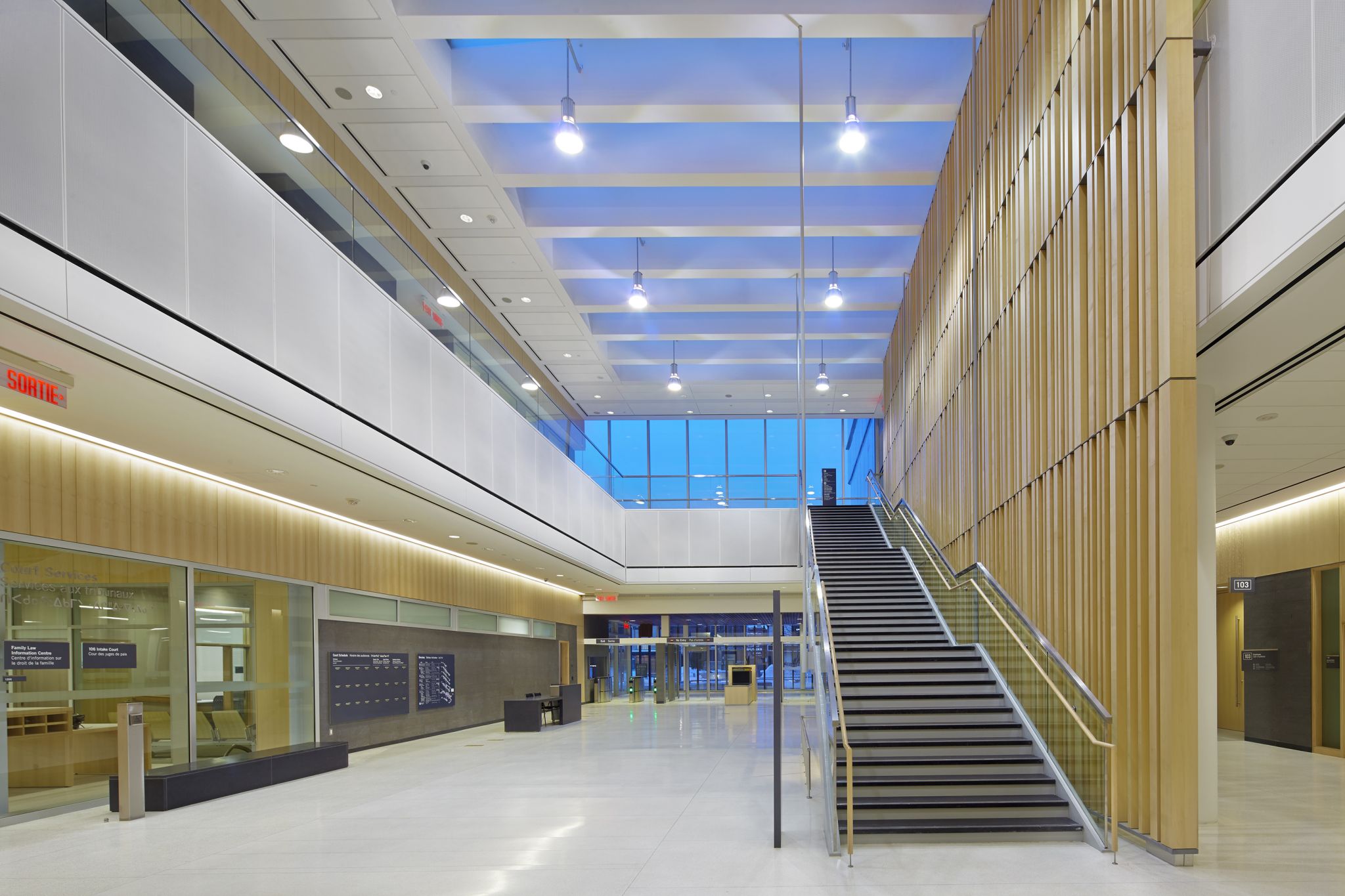
By Claudina Sula, M.Arch., B.Tech. (Arch.), OAA, MRAIC, NCARB, and Steve Titus, B.A.Sc., P.Eng.
Courthouses were historically centrepieces of municipal life, both literally and figuratively. Located in the heart of communities, these buildings formed the core of a city’s civic governance, ensuring peace, justice, and good order. This stature was reflected in the buildings, which were commonly impressive stone and wood edifices designed around a ‘live’ acoustical environment allowing judges and participants to hear everything. However, as the years brought modern technology and evolving needs, these once grand spaces often became closed-in rooms with little natural light, where it became increasingly difficult for occupants to hear the proceedings.
This was the challenge facing the City of Thunder Bay, Ont., which needed to revitalize its court space. The new Thunder Bay Consolidated Courthouse (TBCC) facility, built as a design-build-finance-maintain project for the Ministry of the Attorney General (MAG) was undertaken by the Plenary Justice consortium, comprising the Plenary Group, Adamson Associates Architects, Bird Design–Build Ltd., and Johnson Controls LP. Toronto’s Aercoustics Engineering Ltd., was tasked with ensuring the acoustical performance of the space.
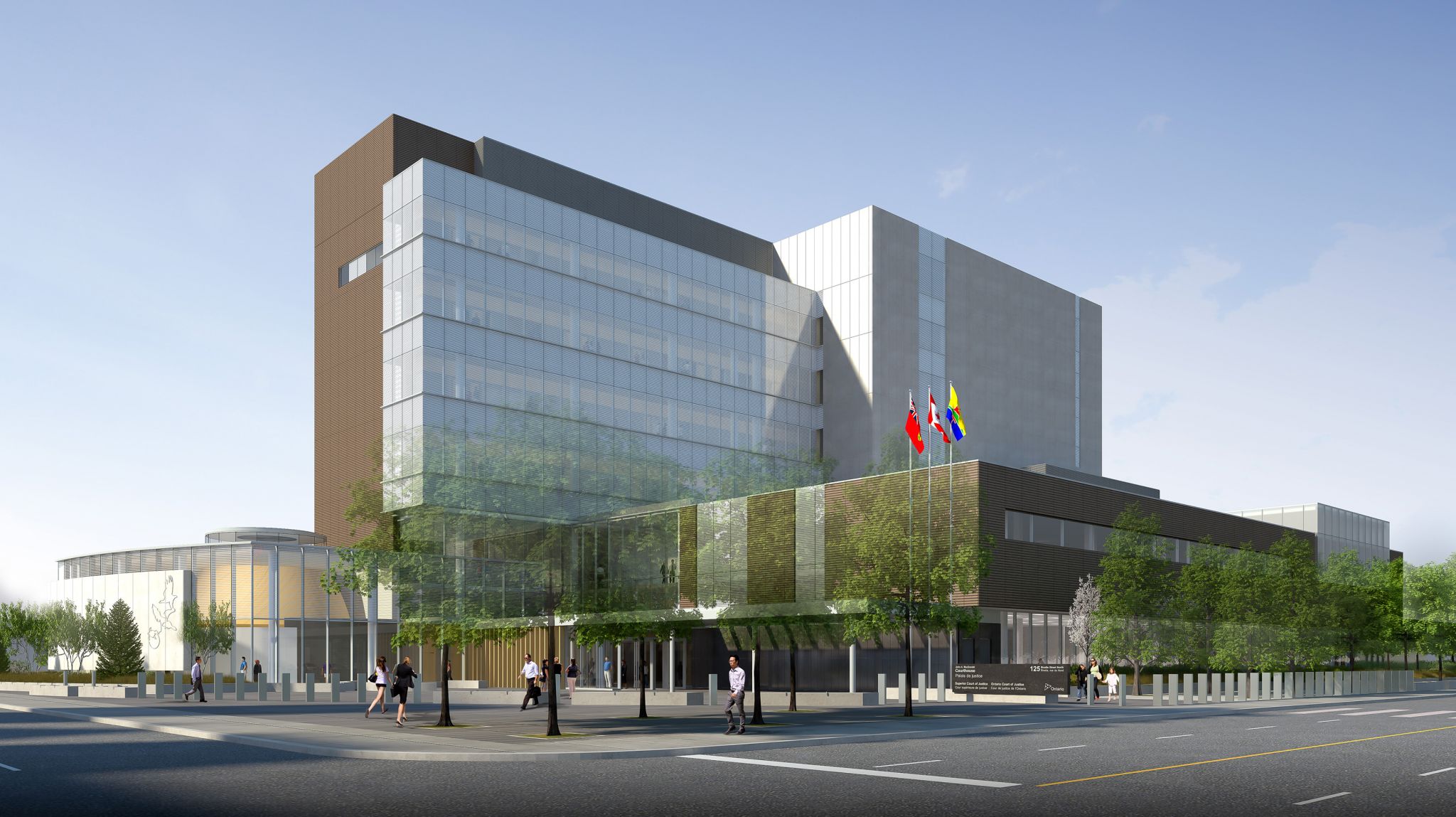
The 23,225-m2 (249,992-sf) building opened in April, replacing two older adjacent courthouses: the Superior Court of Justice and the Ontario Court of Justice in one modern, consolidated facility. The new seven-storey building is located in the downtown core, with an increased number of available courtrooms, improved health and safety standards, and better public access and security.
Natural inspirations
At a design level, the project is consistent with its urban surroundings. The building occupies a city block and the design of each frontage ties in with its surroundings—for example, Brodie Street, the local high street, serves as the formal front. A public outdoor space is provided at the corner of Brodie and Miles, creating a northern anchor to this promenade. The courthouse’s public entrance is accessed from this space as well.
The configuration of the open space works well with the existing Patterson Park, setting the groundwork for a future network of well-used public spaces. Along the northern boundary runs a pedestrian promenade consistent with the neighbourhood and the southern frontage abuts the Victoriaville Mall, an earlier attempt at urban renewal. Chapples Lane, the shared boundary, has been re-imagined as a kind of mews. Complementing the formal public space, an informal public space anchors the internal pedestrian network of the mall, capitalizing on the full southern exposures.
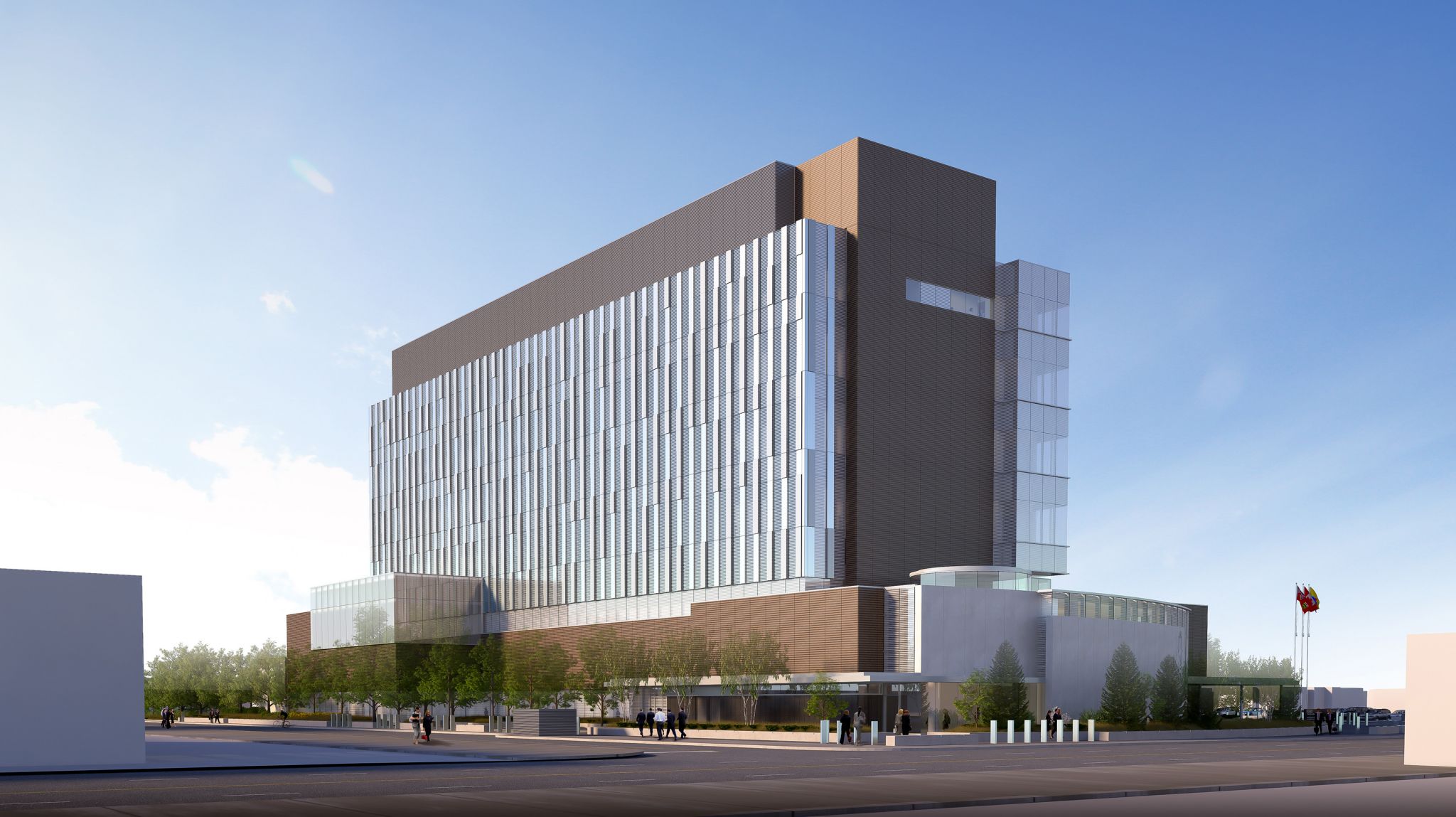
Located on the northern shores of Lake Superior, Thunder Bay is known for dramatic landscapes and natural beauty. The design team looked to this natural environment for inspiration, using the landforms of the Canadian Shield in the building’s form.
Stone and wood are employed prominently at the building’s base, suggesting gravity and permanence befitting an important civic building. The predominantly glass tower that surmounts the base features a glazed curtain wall with textured articulation on the building’s north face, designed to evoke the region’s many waterfalls. A civic plaza on the site’s northeast corner serves as a ceremonial space of assembly for the courthouse, leading to the public entrance. The plaza is augmented by a contemplative public space located off Chapples Lane and linear pedestrian walkways along the site perimeter.
Building materials
The materials palette was derived from local traditions and based on availabilities while also representing the latest advancements in building science. The natural environment served as a reference point for all design decisions, but particularly in the specification of materials.
On the exterior, a deeply pigmented precast concrete with a custom texture has been employed as the principal cladding, alluding directly to the masonry brick heritage of Thunder Bay (and obliquely to the region’s rugged landscape). A lighter tone plays a secondary role referencing historical civic architecture. As a foil to the literal weight and solidity implied, planes of transparent glazed curtain wall of high-performance, low-emissivity (low-e) fritted clear glazing and silvery metal panels are introduced. These are modelled in such a way to suggest the smooth waters of Lake Superior and the textured waterfalls of nearby Mount McKay.
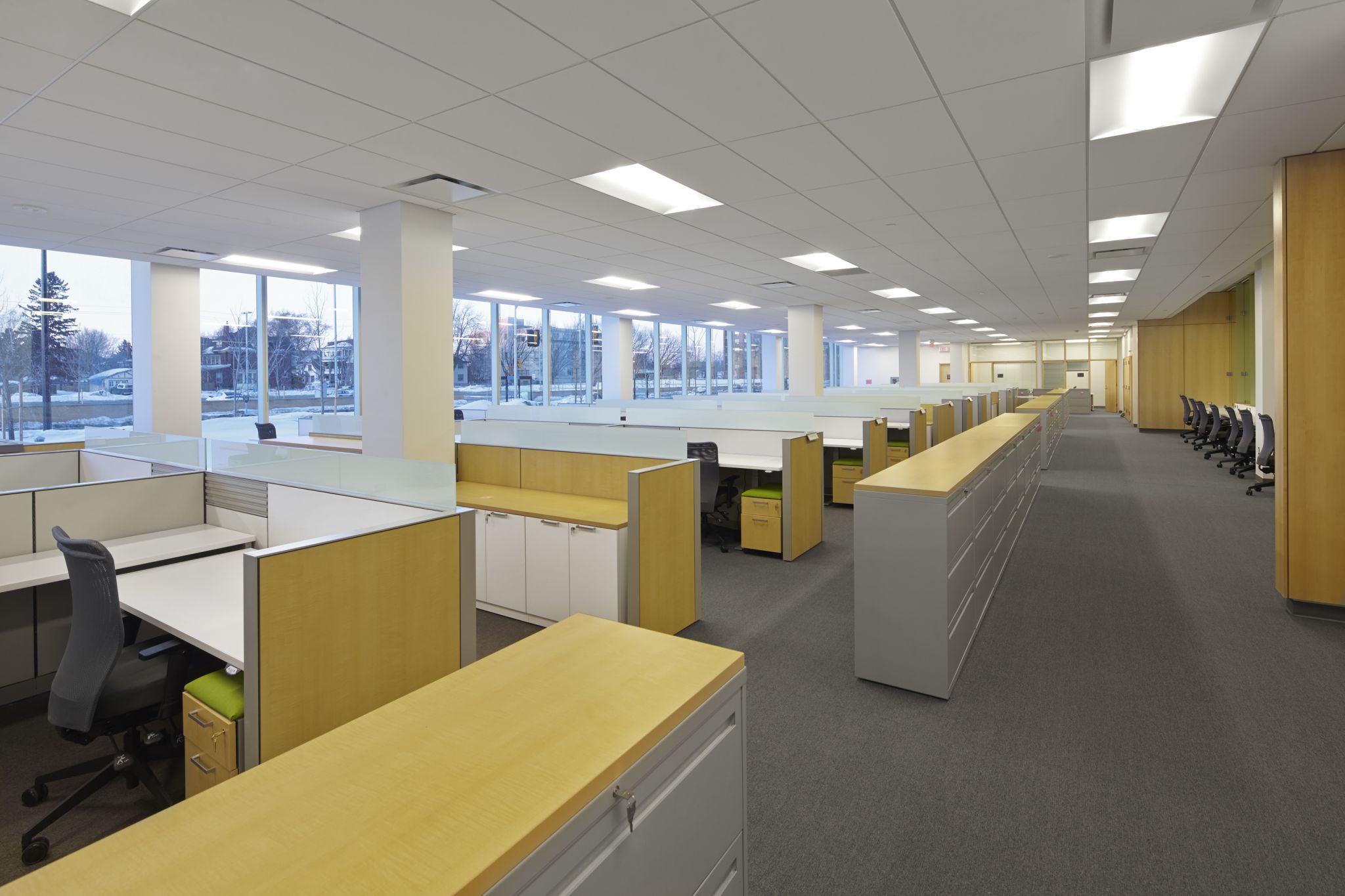
The disposition of the fenestrations takes full advantage of the views of the region’s natural features, as well as maximizing controlled natural light penetration. Dark-toned, regionally sourced granite is used to highlight key entry points as well as paving in the principal public outdoor spaces.
With the abundance of natural light, the materials are shown to their best advantage. In many ways, light itself has been treated as a material. The exterior’s natural stones make their way inside, intentionally blurring the boundaries between the two, whilst ensuring the dignity required by the building type.
Additionally, limestone is introduced on key vertical surfaces making direct reference to courthouse architecture. Light-toned, cast-in-place patterned terrazzo flooring provides a consistent and unifying presence throughout. Against this backdrop of permanent classic materials, light-toned maple has been used on all the abundant millwork and features. Furnished in a semi-matte neutral finish, the effect is of freshly sawn boarding.
A large civic plaza is defined by the placement of granite stone in a simple running bond pattern. Within the building, the two-storey glazed public entrance opens onto a generous lobby faced in natural stone and filled with natural light. This spacious central atrium is a critical part of the building’s intuitive wayfinding solution.
North American courthouses must incorporate three internal circulation systems: public, private (for judiciary and key staff), and secure (for the transport of people in custody). These convene in the courtrooms yet cannot overlap.
“The organization of this circulation impacts everything we do,” explains Adamson Associates Architects’ Claudina Sula. “The challenge, then, is to design a dignified structure meeting all these other programmatic requirements.”
Interior spaces, especially those in the office administrative area, are organised to support wayfinding with minimal signage and to take advantage of daylight and views to the surrounding landscape. Targeting Leadership in Energy and Environmental Design (LEED) Silver certification, the building employs large windows adjacent to the outdoor garden and interior spaces situated to track solar movement throughout the day to maximize daylight.

Acoustical performance
The TBCC’s acoustical design was inspired by a vision to restore the grandeur of some of the older courts—a consideration lost in modern projects which rely too heavily on acoustically absorptive materials.
Aercoustics developed a balanced acoustical design focused on optimizing natural, unamplified speech. The goal was to create a room in which the judge could be heard throughout the courtroom without heavy reliance on an audio/visual (A/V) system. While A/V equipment is required for the operation of the courts, it was necessary to strike a balance between the technical requirement and support for natural speech. When visitors walk into the courtrooms, it is clear the acoustical goals were accomplished. A single speaker (e.g. the judge) can be heard from the front of the room without the need for any amplification.
To achieve this balance, it was essential the ambient noise in the courtrooms was minimized to deliver a certain signal-to-noise ratio. If the background noise was too high, the audibility of unamplified speech was negated. The challenge was reviewed and designers worked with the mechanical team to develop the appropriate design for the mechanical and electrical systems to lessen any noise from building services in the courtroom. Again, people walking into these rooms can now immediately notice they are exceptionally quiet spaces.
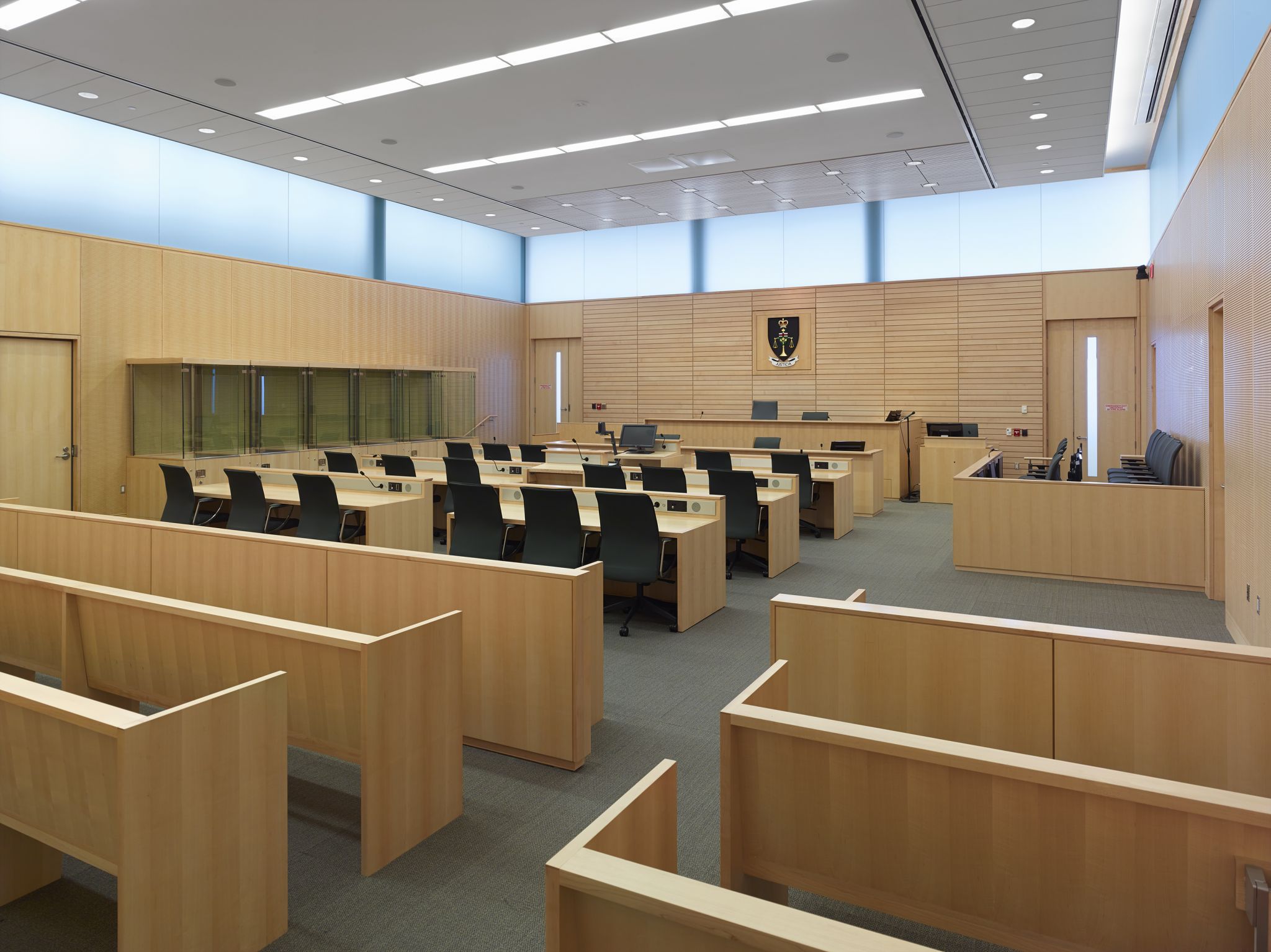
Acoustic designers did not only rely on the standard interior room acoustic metric—reverberation time —to determine the optimal acoustic treatment for the room. Rather, they also leveraged experience and technologies from other service sectors, such as performing arts centres. The overall governing functional parameter was optimizing speech intelligibility. The speech intelligibility was characterized by focusing on distinctness (D50) and acoustic strength (G). These parameters (among others) are more frequently used in the design of performing arts centres.
Both of these metrics are used in the design of performing arts centres because they provide greater detail than solely relying on reverberation time. Reverberation time only speaks to the time it will take for energy to decay in a room. Therefore, it is a useful design parameter, but limited because it does not provide any information about the acoustic quality or when energy may arrive at a listener position.
To optimize the acoustics in any space, acoustical theory suggests that where the energy is coming from and when it arrives at a listening position are both important factors. Distinctness (i.e. D50) is a ratio of the acoustic early energy, and is defined by the amount of energy that arrives at a given position within the first 50 milliseconds of the direct sound. Speech intelligibility can be optimized in a room by increasing the D50, or in other words ensuring more early energy arrives at the listener position. By employing the D50 parameter and reverberation time, the courts were designed to enhance speech intelligibility and ensure useful energy was optimized.
Applying these same principles to the courtrooms’ design created an acoustic environment that is uniform and promotes unamplified speech, while still being able to integrate all required A/V systems into the court functions.

intended as an abstraction of the region’s forests. The decorative friezes located over each courtroom entry also depict one of the key building concepts: Water-Earth-Air.
Acoustic challenges
From an acoustical perspective, the most challenging room for this project was the Aboriginal Conference Settlement Suite (ACSS). This circular room has an elliptical dome, creating acoustical challenges that can manifest in negative acoustical phenomena, such as focusing and ‘whispering.’ Focusing is a phenomenon that creates a high concentration of energy at a specific location. This results in acoustical ‘hot spots’ in certain parts of the room.
The ACSS was designed for the same requirements as any other courtroom, but the space’s geometry demanded a unique treatment scheme. It was determined the circular walls could be used to provide useful acoustical reflections if focusing could be avoided. To achieve this, a wall panel was designed that would allow for reflections while also being diffuse, so the energy could be dispersed and not create a focal point. The overall reverberation time was controlled by treating the domed surface with acoustically absorptive material.
From the project’s outset, the acoustical design for this courthouse was a challenge. It is the first new provincial Ministry of the Attorney General courthouse to be constructed using steel construction. Steel-framed buildings pose distinct challenges for the acoustical design. For example, achieving high degrees of sound isolation as per Ministry of the Attorney General standards of sound transmission class (STC) of 55 or higher is difficult with steel.
STC ratings were developed as a single-number descriptor to provide an indication of a given assembly’s ability to limit airborne sound transmission through it. The rating was developed to focus on the frequencies for human speech, namely 125 through 4000 Hz. Higher STC ratings indicate better-performing assemblies, and are more difficult to achieve.
For the TBCC, acoustical details were developed and implemented to ensure STC-55 could be realized, and this was then validated through testing to confirm the wall assemblies’ performance.
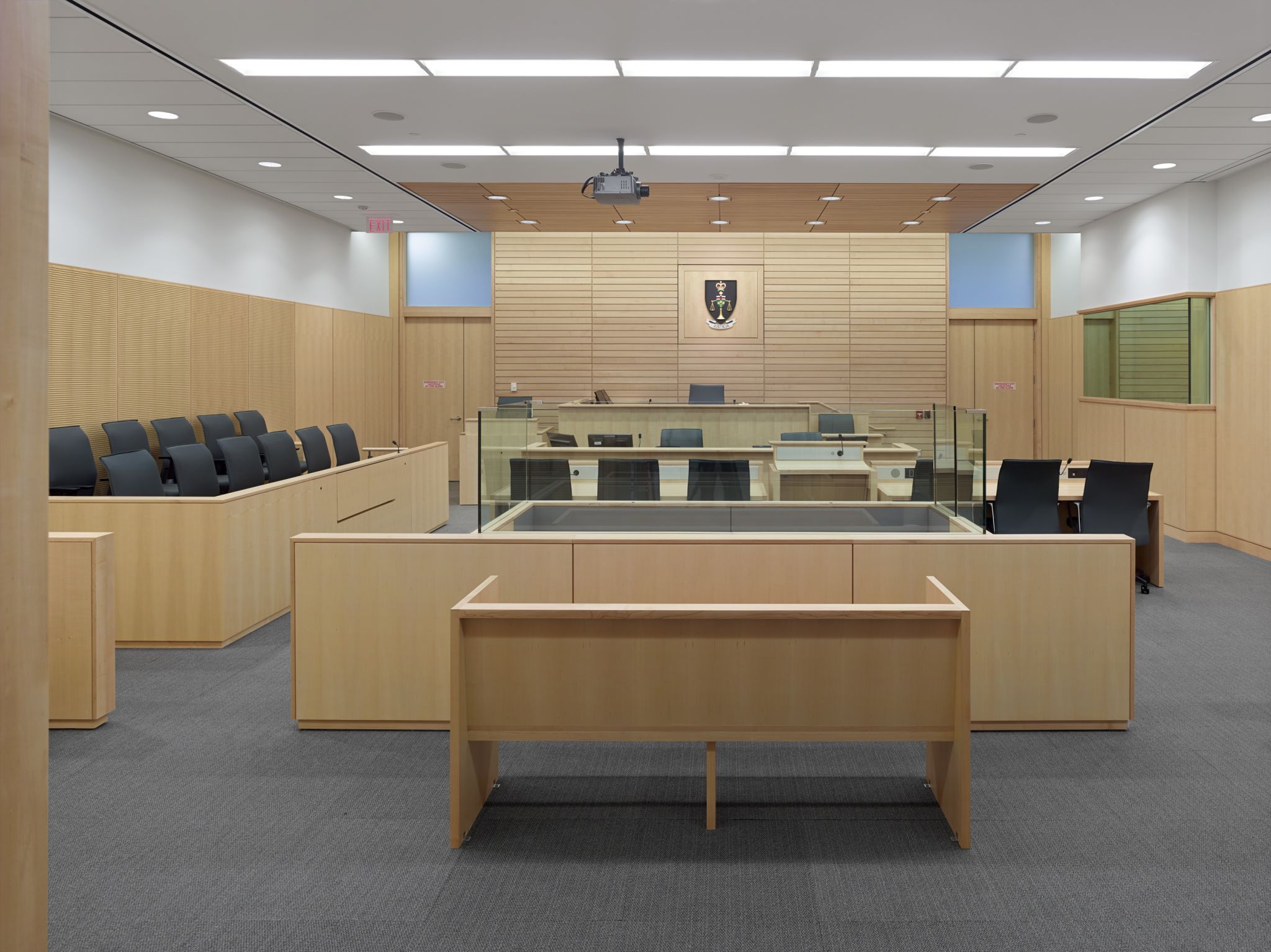
Cultural considerations
Aboriginal input was crucial to the design from the project’s earliest stages. Leaders of various native communities, including an elders’ committee, were consulted to solicit their ideas for the courthouse.
Aboriginal traditions represented in the courthouse design include:
- the courthouse’s front entrance and main entrance of the Aboriginal Conference Settlement Room Suite face east, toward the rising sun to symbolize the beginning of life;
- a garden in the courthouse civic plaza acknowledges Mother Earth, with an open circular sitting area that can be used for smudging, a ritual cleanings; and
- exterior art engravings represent the Seven Grandfather teachings that different animals embody the values of truth, respect, humility, courage, love, honesty, and wisdom.
As discussed earlier, the inclusion of the Aboriginal Conference Settlement Suite was important. The space is the first of its kind in Ontario, designed to give a stronger voice in the justice process to First Nations, Inuit, and Métis people. The suite is a culturally and architecturally relevant space where aboriginal traditions are acknowledged and understood, and where court matters such as case conferences, pre-trials, and family and civil hearings can be dealt with in a way that supports the healing process. The innovative design recognizes the diversity of the City and District of Thunder Bay and Northwestern Ontario.
Located on the ground floor of the courthouse, the suite is circular and features a stone hearth at its centre, which will be used for smudging ceremonies before the start of proceedings. The suite was designed in consultation with ministry policy advisers, court representatives, and members of Aboriginal communities. In a nod to the significant role the courthouse traditionally played in the civic and social realm, this space will also be used for community functions.
Conclusion
All these design features and challenges were only possible as a result of an integrated design approach that was governed by the overall architectural vision for the project.
Universal accessibility is accentuated through the 15 barrier-free courtrooms, including the access to courtrooms, witness stands, and jury boxes, along with infrared hearing assistance and braille signage. Additionally, most courtrooms are provided with simultaneous interpretation, including one permanently built into a jury courtroom.
The result is a thoroughly modern building that looks to the past in its embodiment of the permanence, grandeur, and civic authority of the courthouse, while being open to the future with an innovative and sustainable design that furthers the delivery of justice in Ontario.
 Claudina Sula, M.Arch., B.Tech. (Arch.), OAA, MRAIC, NCARB, is a principal with Adamson Associates Architects. Since joining the firm in 2007, she has led the teams for several significant building projects and judicial studies including the St. Lawrence Market North Building/Provincial Offences Court for the City of Toronto, the Brampton Courthouse Facilities Renewal Study and Master Plan, and the York Region Courts Facilities Renewal Study and Master Plan. Sula can be contacted at csula@adamson-associates.com.
Claudina Sula, M.Arch., B.Tech. (Arch.), OAA, MRAIC, NCARB, is a principal with Adamson Associates Architects. Since joining the firm in 2007, she has led the teams for several significant building projects and judicial studies including the St. Lawrence Market North Building/Provincial Offences Court for the City of Toronto, the Brampton Courthouse Facilities Renewal Study and Master Plan, and the York Region Courts Facilities Renewal Study and Master Plan. Sula can be contacted at csula@adamson-associates.com.
 Steve Titus, B.A.Sc., P.Eng., is president of Aercoustics Engineering, and one of the principals of the company. As the principal in charge of the Thunder Bay Consolidated Courthouse, he was responsible for the project’s acoustical design. Over the last decade, Titus has been responsible for the acoustical design and delivery of several high profile projects such as the Sick Kids Research Tower, Corus Quay, and St. Lawrence Market North redevelopment. He can be contacted by e-mail at stevet@aercoustics.com.
Steve Titus, B.A.Sc., P.Eng., is president of Aercoustics Engineering, and one of the principals of the company. As the principal in charge of the Thunder Bay Consolidated Courthouse, he was responsible for the project’s acoustical design. Over the last decade, Titus has been responsible for the acoustical design and delivery of several high profile projects such as the Sick Kids Research Tower, Corus Quay, and St. Lawrence Market North redevelopment. He can be contacted by e-mail at stevet@aercoustics.com.







